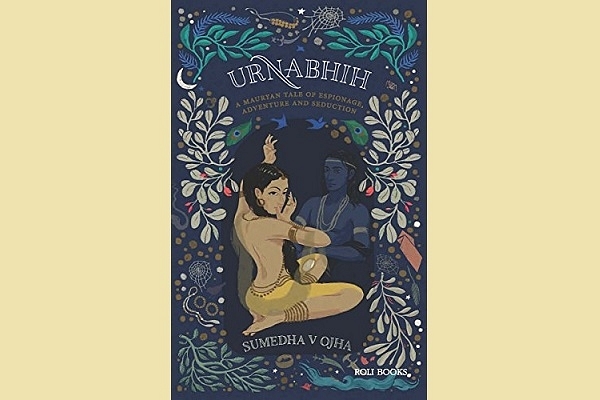Books
A Must-Read For Indian History Enthusiasts: A Review Of Sumedha Verma Ojha’s ‘Urnabhih’
- What left me impressed with the novel is the rooted and responsible feminism as opposed to the angry, rebellious and almost misandrist version of feminism that is seen in most of today’s literature.

(Photo: Amazon)
Sumedha Verma Ojha. Urnabhih: A Mauryan Tale of Espionage, Adventure and Seduction. Roli Books. 2014.
Empires rise. Empires fall. We read about the kings and the kingmakers. We learn about the landmark battles, coups and takeovers. Where Urnabhih stands out is in narrating the tale from the perspective of those who shouldered the crucial responsibility of ensuring the stability of an empire – the spies. The author, Sumedha Verma Ojha, impresses with her way of balancing various aspects of romance, intrigue, adventure and emotions while not compromising with the pace of the narration.
The tale starts with the entry of the protagonist, Misrakesi, a dancer who enters Magadha with a vengeance in mind and ends up in the spy network of Chanakya, the enigmatic kingmaker, politician and accomplished guru in statecraft. To those who watched the critically acclaimed TV series Chanakya, this book starts like almost a sequel, but with a change in the point of view. The author delves into the details of the topography of the city of Pataliputra while detailing the early intrigues that Chandra Gupta Maurya faced and Misrakesi’s role in ensuring his coronation. Fans of Chanakya serial get to catch up with old friends like Shrunottara, Siddharthak and Akshay.
Characterisation is another aspect where Urnabhih impresses. Misrakesi comes off as a fiercely independent woman, a ravishing dancer and someone who wonderfully balances her ambitions with loyalty to her role as a spy. The male protagonist Pushyamitra (not to be confused with the founder of the Sunga dynasty who comes quite some generations later in the history) keeps the reader hooked. Arrogant, bossy and patronising as he is, Pushyamitra also has an endearing, sensitive side and manages to win hearts of the readers. The ‘boss-employee’ relationship between Pushyamitra and Misrakesi that blooms into romance while encountering roadblocks is something to be read and savoured.
Ojha’s knowledge about the social norms, statecraft and policy of those times, rooted in Arthashastra, flows and blends with the plot. Revealing any more would spoil the tale. I was particularly impressed with the economics that was enunciated in a particular episode that involved fake coin minting that threatened the Mauryan empire with dire consequences.
Misrakesi, after her initial success, finds herself caught up in the web of intrigues that sends her on a journey to Kekaya, the ally-turned-rival of Magadha.
What left me impressed with the novel is the rooted and responsible feminism as opposed to the angry, rebellious and almost misandrist version of feminism that is seen in most of today’s literature. Often, feminist stories end up betraying the principle and glorifying masculinity with their tomboyish and overtly aggressive heroines who seem to think being unreasonable is the way to assert independence. But in Urnabhih, not only Misrakesi but even the other female characters brim with confidence in themselves and make their presence felt.
The portrayal of society too can shatter some long-drawn stereotypes we’ve all had about ancient India. Misrakesi herself is a multi-faceted and well-rounded character who seems to know when to fight back, when to reason, when to manipulate and when to sweet-talk. Definitely a case study worth exploring for modern Indian writing-enthusiasts.
Last but not the least is the classily narrated erotica. Often in most other books, the sexual scenes either disappoint me or make me want to throw up. With Urnabhih, however, I can proudly confess that the love-making scenes had me going back and re-reading the whole book for the second time. Opposed to Western erotica, where the act of sex is burdened with unnecessary guilt, Urnabhih leverages the Shringara rasa of Indic literature. It emphasises the Indic value system where Kama, the desire, is held on a pedestal as high as Dharma and Artha. As if to echo this conclusion of mine, Pushyamitra declares his faith in this delicate yet cherish-worthy balance between the Purusharthas towards the end of the book. It can engage not only the reader’s senses but also the mind and soul.
One minor aspect where the book falters is in giving a sense of closure in the end even as there is a sequel coming up. A more intriguing end to the book could have kept the reader waiting for the sequel. But as an ardent reader of historical fiction, I am looking forward to reading the second book of Urnabhih. Definitely a must-read for those interested in the history of India.
This piece was first published on the writer’s blog and has been republished here with permission.
Support Swarajya's 50 Ground Reports Project & Sponsor A Story
Every general election Swarajya does a 50 ground reports project.
Aimed only at serious readers and those who appreciate the nuances of political undercurrents, the project provides a sense of India's electoral landscape. As you know, these reports are produced after considerable investment of travel, time and effort on the ground.
This time too we've kicked off the project in style and have covered over 30 constituencies already. If you're someone who appreciates such work and have enjoyed our coverage please consider sponsoring a ground report for just Rs 2999 to Rs 19,999 - it goes a long way in helping us produce more quality reportage.
You can also back this project by becoming a subscriber for as little as Rs 999 - so do click on this links and choose a plan that suits you and back us.
Click below to contribute.
Latest